Music is the universal language
“Glory to God in the highest heaven, and on earth peace to those on whom his favor rests.” - Luke 2:14
Norse Guitar Feeds
Why shred guitar died in the ’90s, according to Polyphia’s Tim Henson

Polyphia’s Tim Henson has offered his take on why shred guitar fell out of fashion in the ’90s, noting how an overload of copycats had watered down what made it exciting in the first place.
In a new interview with The Music Zoo, the 31-year-old guitarist explains how the ’80s ‘shred boom’ ultimately sabotaged itself. He says the era became oversaturated with players chasing technical fireworks without the feel that made the original innovators – from Jimi Hendrix to Eddie Van Halen – so compelling.
“I guess the thing is, when somebody does the cool thing, and they do it so well – you think about Hendrix and those cool licks, that came from that awesome, incredible generation, and probably even before Hendrix, where they were probably doing those kinds of licks too… And then, everybody wants to sound like that,” says Henson [via Ultimate Guitar]. “But [only] the 1% are hitting the feel, and everything else is falling flat. And, you know, that’s kind of just what happens, I guess.”
“Like, when somebody like Eddie comes out and does the thing, and it’s the cool thing, and then everybody else wants to sound like the cool thing, but they’re kind of — I don’t want to say bastardising, but they’re watering it down a little. But it takes that; that’s needed, because it pushes things forward.”
According to Henson, the scene had reached a breaking point by the late ‘80s.
“I feel like, around the ’80s, all the shredders kind of ganged up together,” he says. “And when that happened, it was so heavily weighed on the shredder side, that the universe needed to balance itself out and pop out Kurt Cobain. And then, all of a sudden, it’s not cool to shred.”
The post Why shred guitar died in the ’90s, according to Polyphia’s Tim Henson appeared first on Guitar.com | All Things Guitar.
The common guitarist bad habit Joe Bonamassa finds “so unappealing”

Joe Bonamassa has some timeless advice for guitar players – and a few thoughts on the “unappealing” habits that turn jam sessions into ego shows.
In a new interview for Gibson Gear Guide promoting his latest collaboration with Epiphone – the ’59 Les Paul Custom, a recreation of his “extremely rare” Gibson “Black Beauty” LP – Bonamassa lays out what he sees as a common bad habit among guitarists: failing to “read the room.”
“As a player, you’ve got to read the room,” says Bonamassa. “If you’re getting called up [onstage] for a jam, or called up for one song, there shouldn’t be a technical team in tow with a pedalboard the size of a Fiat.”
There’s no need, he adds, for an “F1 pit crew” just to play a three-minute jam. “Just plug straight in, man. We’re not making our careers here. Just use the volume and tone controls, and figure it out.”
His interviewer, Dinesh Lekhraj, then notes how Bonamassa practices what he preaches in his own sessions, often plugging straight into whatever amp’s available in the room during shoots.
“I think we get caught up in, ‘Is the tone right? Is the volume right?’” says Lekhraj.
“Exactly,” Bonamassa replies. “And if you want a Tube Screamer or something like that, great. Stick it on the amp and go.”
“If it’s your gig and if it’s your situation and you set it up, then yeah, go down as many rabbit holes plug it all in – because that’s your gig. I mean, if you’re sitting in with somebody, that’s a little different story.”
The guitarist also describes how “unappealing” it is when jam sessions spiral into all-out guitar duels.
“I’ve been onstage plenty of times with five or more guitar players, and the greatest asset you have at your disposal is the volume control,” says Bonamassa. “When somebody’s soloing and there are five guitar players, it shouldn’t be on.”
“Leave some space,” he continues. “And then when they point to you, go for it. You wanna make music for music’s sake and not your sake. The days of those Ralph Macchio and Steve Vai duels are long gone. It is so unappealing to sit there and watch that go down.”
That said, Bonamassa admits there’s one exception to that rule.
“The only time I’ll do it – and it’s fun because I love the man and we have such a mutual respect for one another – is when Eric Gales gets onstage,” he says. “We both know we’re going to get a black eye and a bloody nose. We’re going for it, and the crowd loves it.”
“But it serves a purpose because it’s a spectacle, it’s P.T. Barnum juggling a polar bear on a unicycle. But in other situations, you want to be respectful to your fellow players.”
The post The common guitarist bad habit Joe Bonamassa finds “so unappealing” appeared first on Guitar.com | All Things Guitar.
Martin Road Series SC-10E review: “I’ve played every iteration of the SC platform that Martin has produced and this one is my favourite”

$1,099/£999, martinguitar.com
Martin first debuted the hugely polarising SC acoustic guitar back in 2020 – a radical and bold move for America’s oldest surviving guitar brand that put offset looks and maximum playability at the forefront of things.
Many thought it would be a flash in the pan excursion at the time, but in the five years since, Martin has continued to iterate on the concept, gradually making the SC a more and more accessible and affordable acoustic guitar model.
For 2025, Martin has moved the Mexico-made SC-10E into the Road Series – and in doing so has made it the most affordable and accessible SC model yet.
 Image: Press
Image: Press
Martin SC-10E – what is it?
You may remember Guitar.com reviewing a Mexico-made SC-10E a few years ago, and given that you’re well within your rights to enquire as to whether we’re just reviewing the same product twice here – because on the surface the Road Series SC-10E seems pretty damn similar to the previous version
So you get the same super-thin satin natural finish over the body and neck, you get a spruce top and a select hardwood neck (the term Martin uses as a catch-all for Honduran mahogany, Spanish cedar, Sapele, Sipo, and African mahogany – it can be any of these depending on the supply situation), and you get the same ultra-playable Low Profile Velocity neck profile.
You also get that all-important Sure Align Linear Dovetail Neck joint. This means there’s a securing bolt in the back of the body and a neck shim inside the body that allows you to set your own neck height preference for maximum player comfort. Inside you’ll also find the SC-specific Tone Tension X-bracing inside, and the same Fishman MX-T electronics system inside.
So what is different? Well quite a big thing actually – the original SC-10E had a koa laminate back and sides, whereas this guitar sports an all-sapele arrangement. Less importantly, the headstock has been overhauled visually – gone are the black matt tuners and dark-stained fascia, replaced with a more classic rosewood-capped Martin peghead and chrome tuners.
 Image: Press
Image: Press
Martin SC-10E – feel and sounds
Obviously, from the sheer look of the thing you can tell from the outset that this is not your traditional Martin guitar, and so it is when you pick it up and start playing. The all-over satin finish makes the guitar instantly more comfortable and playable out of the gate – and what’s more, you aren’t muffling the vibration of the wood with a thick gloss coating either.
In practice, this means that the guitar is vibrant and rings clearly with plenty of midrange. Sapele is a similar wood to mahogany, and so you have that inherent warmth that sets this guitar apart tonally somewhat from the brighter and more direct sound of koa. You don’t get the boominess or higher trebles that you might find in a traditional Martin dread, but the tradeoffs are plain to see.
Because ultimately, the real reason someone picks up an SC model is the playability, and here it really does still feel like no other acoustic guitar on the market. The combination that the body shape, neck join and the profile all combine to make this a guitar that plays like an electric without ever not feeling like an acoustic – you can go to places you’d have never considered on a regular flat-top, but it still keeps the inherent tone, vibration and heft that you don’t get in a crossover or hybrid instrument.
Plugged in, the Fishman system does a nice job of replicating the guitar’s inherent tonality – it’s full and warm plugged in, but still midrange forward, which works great backing up vocalists or yourself. The built-in tuner is also very accurate, and is bright and clear enough to easily see on a dimly-lit stage.
 Image: Press
Image: Press
Martin SC-10E – should I buy one?
If you’re looking for a traditional Martin look, sound and feel, obviously the SC-10E is not for you, but provided that you’re not put off by the asymmetrical body style, there are more reasons to try one of these guitars out than not.
I’ve played every iteration of the SC platform that Martin has produced and this one is my favourite. I prefer the warmer frequencies that the sapele wood generates compared to the koa version, and I like the more restrained and traditional cosmetics here. Because when you’re sat playing it, this feels and sounds every inch a classic Martin guitar – but with a level of playability that opens up a whole new musical plain for you to explore.
You also can’t really knock the price – at barely over $1,000 this is the most affordable SC guitar yet, which should help put the guitar in the hands of more curious and experimental players who will truly maximise its potential. And that’s a good thing for everyone.
 Image: Press
Image: Press
Martin SC-10E – alternatives
A more overtly hybrid electric option that blends electric playability with acoustic tones is the Taylor T5z Classic ($2,499). Another offset hybrid acoustic-electric guitar is the Fender Acoustasonic Player Jazzmaster ($1,299/£1,049), while the Highway Series Dreadnought ($999/£849) offers a classic shape with an ultra-thin body. If your main concern is sounding great plugged in while having a more ergonomic body design, the LR Baggs AEG-1 ($1,599) is a remarkable amplified acoustic.
The post Martin Road Series SC-10E review: “I’ve played every iteration of the SC platform that Martin has produced and this one is my favourite” appeared first on Guitar.com | All Things Guitar.
Stompboxtober 2025: Hotone

Don’t just echo—immerse. Enter today’s #Stompboxtober giveaway for a chance to WIN the Hotone Verbera convolution reverb — double engines, 120 built‑in IRs, stereo magic, and sonic depth to lose yourself in. Come back tomorrow for your next shot at gear you’ll love!
Stompboxtober 2025 - Win Pedals All Month Long!
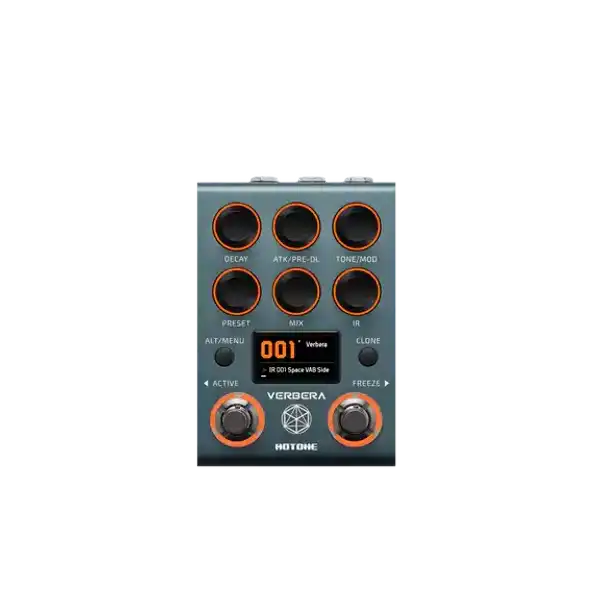
Ever imagined your sound echoing through a sold-out stadium? Or reverberating off the metallic walls of a NASA spacecraft hangar? What if your guitar fell into a cosmic white hole… or drifted through the vaulted ceilings of a centuries-old cathedral?
Welcome to Verbera — where imagination meets reality. This is not your typical software convolution plugin. Verbera is a standalone, hardware-based convolution reverb pedal — with Instant IR loading, stunning tweakability, and boundless sonic range. Whether you’re recreating iconic spaces, vintage hardware, or crafting otherworldly reverbs never heard before, Verbera gives musicians and engineers a powerful new tool for both live and studio setups.

Hotone Verbera Convolution Reverb Pedal
Neural NanOS 2.0.0 Review
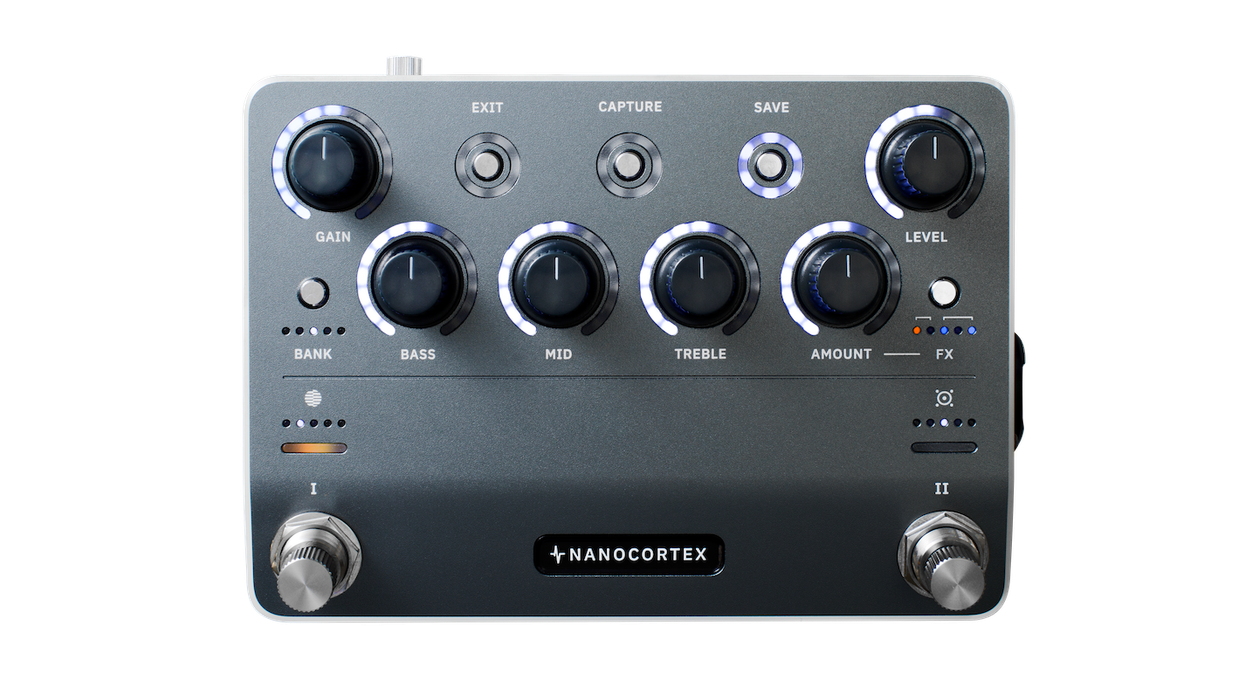
Neural DSP’s Nano Cortex for dyed-in-the-wool analog advocates new to the concept, is a whole rig—digital amp, cabinet simulator, effects unit, and capture device—in a box. It’s also a 24-bit, 48k Hz audio interface that can be powered by a laptop or power bank via USB-C. We reviewed the Nano Cortex upon its release in 2024. Like any new release, it left some hardcore users wanting for certain features. Some users found the effects roster underwhelming. There were also limitations about where you could situate effects relative to an amp capture. With a raft of new effects and greater flexibility, though, Neural’s 2.0.0 update addresses many concerns of power users and casual adopters alike.
Ever Evolving Technology
When the $549 Nano Cortex was released, it was a hit. The idea of a small, pocket-sized version of a Quad Cortex that weighs only 1.36 pounds—and at a third of the cost—had many guitarists drooling. But the truth is that while they are part of the same lineage, the Nano Cortex can’t match the flexibility of the Quad Cortex. This led to some confusion, and in some cases, unmet expectations.
The new, free NanOS 2.0.0 update addresses some of those letdowns with a much-expanded collection of 47 new effects—including dirt options, which, oddly, weren’t offered in the first OS version. (There is, however, only a single fuzz—a Fuzz Face emulation—which hints at the challenges of successfully modeling fuzz’s more chaotic nature.) There’s also an IR loader and global bypass to turn off IRs on all presets when you play the Nano Cortex through a real cabinet. The more customizable signal chain is also a very big deal.
The effects slots are more flexible, too. EQs and compressors can be set up in any slot—pre-or-post capture. Overdrive and wah effects can go into any pre-capture slots, while modulation, delay, and reverbs are assigned slots in the post-capture area. (The tape delay is warm, and a highlight.) Delay is only available in post-capture slot 2, before the reverb, which can only be slotted in post-capture 3 position. As you can see, NanOS 2.0.0 has opened up more possibilities, but limitations remain, especially for players that experiment with unorthodox setups.
Magic in the Clouds
Unlike the Quad Cortex, the Nano does not have a 7" touchscreen and the controls are very utilitarian. There are a few knobs and two hybrid footswitches/rotary knobs, but to really maximize the potential of the unit and manage your presets, you need to use Neural DSP’s Cortex Cloud app with your phone or tablet.
NanOS 2.0.0 has opened up more possibilities, but limitations remain—especially for players that experiment with unorthodox setups.The app makes things way easier, and using the Nano Cortex without it seems almost unimaginable. However, if your phone is the main interface, you can’t use your phone simultaneously for other common functions like filming videos at a gig or playing backing tracks. That said, the app lets you do a lot …once you get up and running. I can generally get around the basic functions of most multi-effects modeler-type systems, but being new to the Neural DSP ecosystem, it took me some time to get a workflow going. When I got it all figured out, the app made it very easy to instantaneously control parameters, maneuver complete signal chains, and capture pedals and amps.
Captivating Captures
Using the Nano Cortex, I easily captured the hi and lo channels of my Mesa/Boogie Flux Five, as well as the vintage, modern, and combined vintage-plus-modern modes of my Wampler Dual Fusion. I initially set up a lead sound with delay from my Yamaha UD Stomp situated after the Flux Five, but learned the hard way that a “capture” is a moment in time that cannot accommodate time-based effects.
Using a Shure SM57 mic, I captured the clean tones from my Ampeg SJ12-R and vintage black-panel Fender Deluxe combos. Each capture took about three minutes and nailed the sound. Impressively, the touch-sensitive qualities of the pedals and amp were present—I could dig in hard or play soft, and feel the Nano Cortex respond just like my Dual Fusion pedal and amps. One bummer about those clean Fender Deluxe sounds, though: The new effects in NanOS 2.0.0 do not include tremolo or spring reverb—a strange omission given how many vintage Fender amps fans exist among the Neural user community. That omission aside, I enjoyed the ethereal cave reverb effect and assigned it to one of my clean captures to satisfying effect.
In addition to allowing you to capture your own gear, the Nano Cortex also comes with many preloaded captures of amps like the Mesa/Boogie JP2C, Marshall Silver Jubilee, and Peavey 5150, among many others. There are also 10 IRs and two pre-and three post-FX blocks. And the Cortex Cloud app offers a ton of free presets, which have a complete chain of captures and effects from artists like Plini and Cory Wong.
The Verdict
I recently balked at using a favorite vintage ’60s Fender tube amp for a bar gig as visions of spilled beer filled my head. Instead, I used a pretty underwhelming solid-state alternative. But if I had had the Nano Cortex, I could have used captures of that vintage Fender, a few pedals, and put the whole setup in my gig bag. That part of the Nano Cortex experience remains a game changer. But as the incremental improvements in the NanOS 2.0.0 show, there is still ground to cover.
Neural NanOS 2.0.0 Review

Neural DSP’s Nano Cortex for dyed-in-the-wool analog advocates new to the concept, is a whole rig—digital amp, cabinet simulator, effects unit, and capture device—in a box. It’s also a 24-bit, 48k Hz audio interface that can be powered by a laptop or power bank via USB-C. We reviewed the Nano Cortex upon its release in 2024. Like any new release, it left some hardcore users wanting for certain features. Some users found the effects roster underwhelming. There were also limitations about where you could situate effects relative to an amp capture. With a raft of new effects and greater flexibility, though, Neural’s 2.0.0 update addresses many concerns of power users and casual adopters alike.
Ever Evolving Technology
When the $549 Nano Cortex was released, it was a hit. The idea of a small, pocket-sized version of a Quad Cortex that weighs only 1.36 pounds—and at a third of the cost—had many guitarists drooling. But the truth is that while they are part of the same lineage, the Nano Cortex can’t match the flexibility of the Quad Cortex. This led to some confusion, and in some cases, unmet expectations.
The new, free NanOS 2.0.0 update addresses some of those letdowns with a much-expanded collection of 47 new effects—including dirt options, which, oddly, weren’t offered in the first OS version. (There is, however, only a single fuzz—a Fuzz Face emulation—which hints at the challenges of successfully modeling fuzz’s more chaotic nature.) There’s also an IR loader and global bypass to turn off IRs on all presets when you play the Nano Cortex through a real cabinet. The more customizable signal chain is also a very big deal.
The effects slots are more flexible, too. EQs and compressors can be set up in any slot—pre-or-post capture. Overdrive and wah effects can go into any pre-capture slots, while modulation, delay, and reverbs are assigned slots in the post-capture area. (The tape delay is warm, and a highlight.) Delay is only available in post-capture slot 2, before the reverb, which can only be slotted in post-capture 3 position. As you can see, NanOS 2.0.0 has opened up more possibilities, but limitations remain, especially for players that experiment with unorthodox setups.
Magic in the Clouds
Unlike the Quad Cortex, the Nano does not have a 7" touchscreen and the controls are very utilitarian. There are a few knobs and two hybrid footswitches/rotary knobs, but to really maximize the potential of the unit and manage your presets, you need to use Neural DSP’s Cortex Cloud app with your phone or tablet.
NanOS 2.0.0 has opened up more possibilities, but limitations remain—especially for players that experiment with unorthodox setups.The app makes things way easier, and using the Nano Cortex without it seems almost unimaginable. However, if your phone is the main interface, you can’t use your phone simultaneously for other common functions like filming videos at a gig or playing backing tracks. That said, the app lets you do a lot …once you get up and running. I can generally get around the basic functions of most multi-effects modeler-type systems, but being new to the Neural DSP ecosystem, it took me some time to get a workflow going. When I got it all figured out, the app made it very easy to instantaneously control parameters, maneuver complete signal chains, and capture pedals and amps.
Captivating Captures
Using the Nano Cortex, I easily captured the hi and lo channels of my Mesa/Boogie Flux Five, as well as the vintage, modern, and combined vintage-plus-modern modes of my Wampler Dual Fusion. I initially set up a lead sound with delay from my Yamaha UD Stomp situated after the Flux Five, but learned the hard way that a “capture” is a moment in time that cannot accommodate time-based effects.
Using a Shure SM57 mic, I captured the clean tones from my Ampeg SJ12-R and vintage black-panel Fender Deluxe combos. Each capture took about three minutes and nailed the sound. Impressively, the touch-sensitive qualities of the pedals and amp were present—I could dig in hard or play soft, and feel the Nano Cortex respond just like my Dual Fusion pedal and amps. One bummer about those clean Fender Deluxe sounds, though: The new effects in NanOS 2.0.0 do not include tremolo or spring reverb—a strange omission given how many vintage Fender amps fans exist among the Neural user community. That omission aside, I enjoyed the ethereal cave reverb effect and assigned it to one of my clean captures to satisfying effect.
In addition to allowing you to capture your own gear, the Nano Cortex also comes with many preloaded captures of amps like the Mesa/Boogie JP2C, Marshall Silver Jubilee, and Peavey 5150, among many others. There are also 10 IRs and two pre-and three post-FX blocks. And the Cortex Cloud app offers a ton of free presets, which have a complete chain of captures and effects from artists like Plini and Cory Wong.
The Verdict
I recently balked at using a favorite vintage ’60s Fender tube amp for a bar gig as visions of spilled beer filled my head. Instead, I used a pretty underwhelming solid-state alternative. But if I had had the Nano Cortex, I could have used captures of that vintage Fender, a few pedals, and put the whole setup in my gig bag. That part of the Nano Cortex experience remains a game changer. But as the incremental improvements in the NanOS 2.0.0 show, there is still ground to cover.
Stompboxtober 2025: Ernie Ball
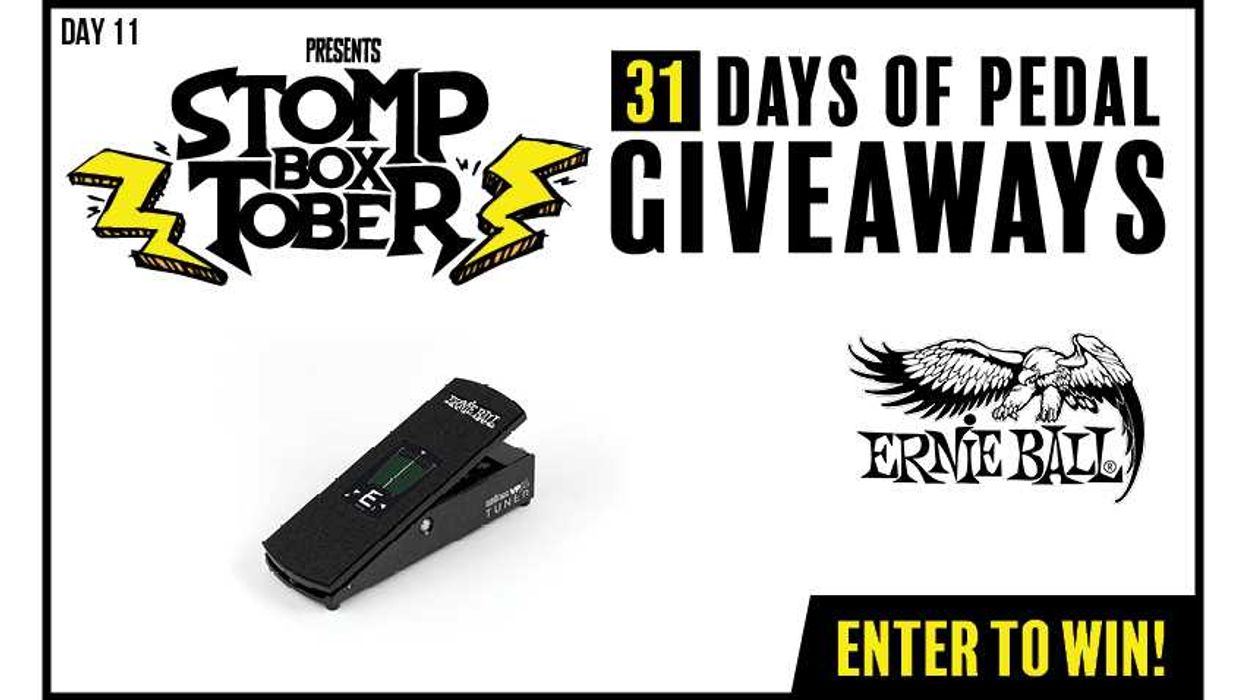
Tune and control in one sweep! Enter today’s Stompboxtober giveaway for your chance to WIN the Ernie Ball VP Jr. Tuner/Volume Pedal — get silent tuning, full volume control, and sleek efficiency all in one pedal. Don’t forget to come back tomorrow for another stellar giveaway!
Stompboxtober 2025 - Win Pedals All Month Long!
Ernie Ball VPJR Tuner Pedal
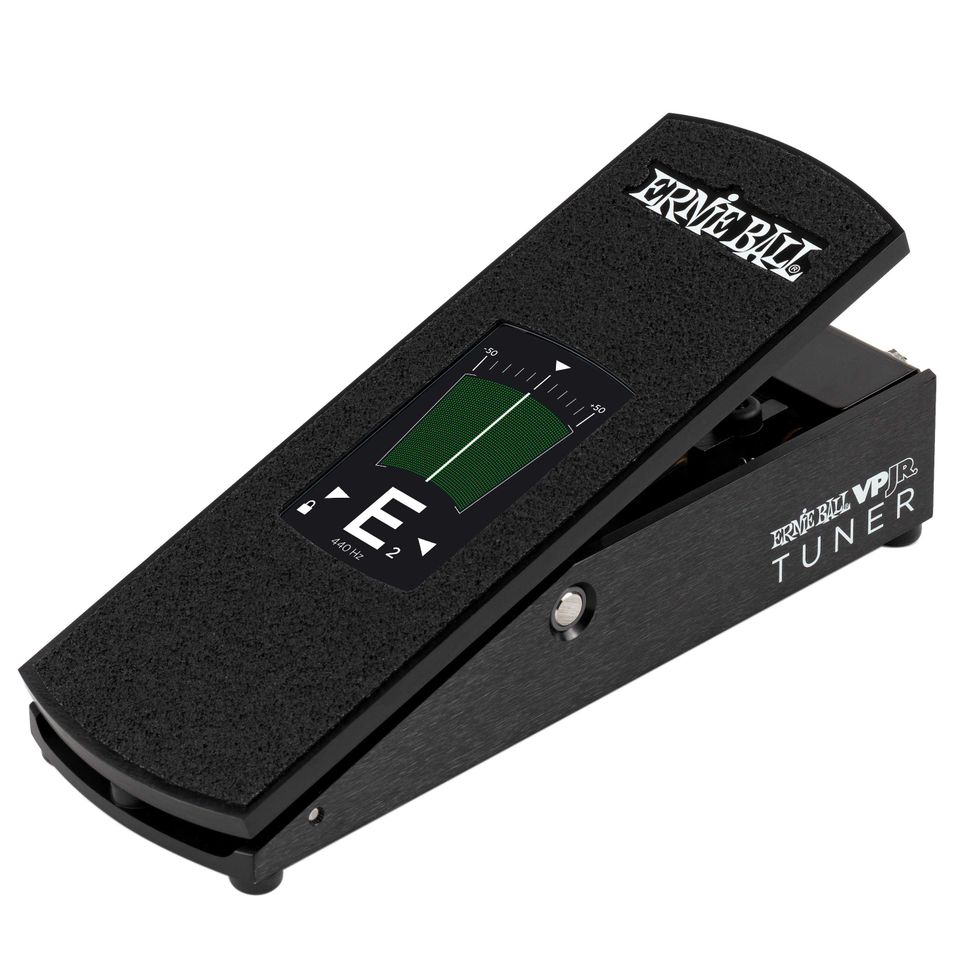
The VPJR Tuner pedal combines Ernie Ball’s world-renowned volume pedal with an enhanced definition digital guitar tuner. In the heel-down position, the pedal’s vibrant touchscreen automatically enters tuner mode, allowing for silent tuning. As the foot sweeps forward, the screen switches to volume mode, providing a graphic display of your volume level. Alternatively, the screen can remain in volume mode or tuner mode, regardless of the pedal’s position in the sweep. Simply double tap on the touchscreen to toggle between modes. The VPJR Tuner provides the same rugged construction and time-tested performance as Ernie Ball’s traditional volume pedal.
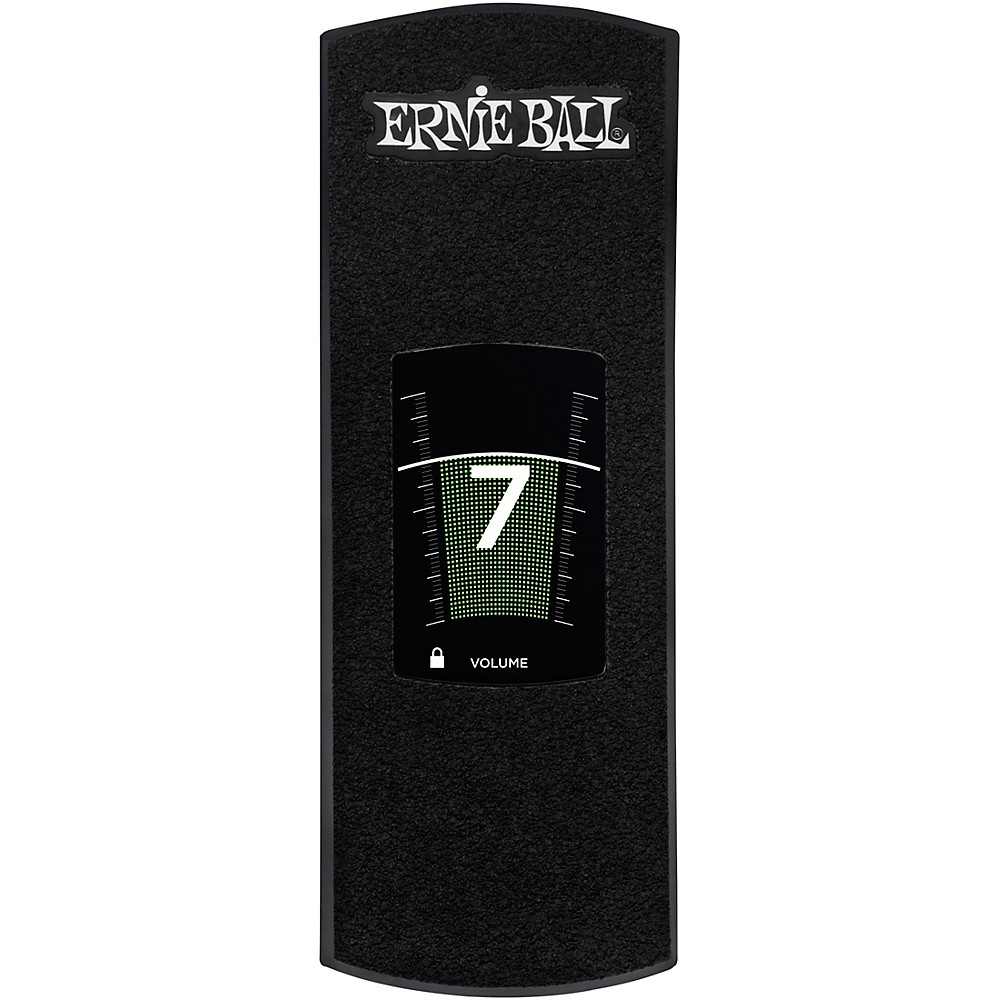
Ernie Ball VPJR Tuner Volume Pedal Black
Willie Nelson and the Lost Art of Relentless Creation

Over the years, I’ve done two TV shows with Willie Nelson—Nashville Star in 2004, and a CMA award show a few years later. On TV sets, there’s a lot of standing-around time while producers fiddle with lights and other details. What struck me both times was that whenever the action stopped, Willie did not stand around: He’d get on the ground and rip out a bunch of pushups. No wonder that today, at 92, Willie Nelson is still out there, braids swinging and beating Trigger, his Martin N-20 he bought new in 1969, like it owes him money. Willie and that guitar have both ridden some hard miles that have left them a bit threadbare, but to my ears, their voices are a bit warmer, softer, and darker for it—like weathered tapestry. You have to marvel at his endurance. In an era where artists tour sparingly and drop albums like rare comets, Willie Nelson is a throwback to a time when musicians lived to play and create, night after night, record after record.
Willie’s numbers tell the story. Since his debut album, …And Then I Wrote, in 1962, he’s released 153 albums—76 solo studio records, 26 collaborations, 14 live albums, 51 compilations, and soundtracks like The Electric Horseman and Honeysuckle Rose. That’s roughly 2.5 albums per year over 62 years. His latest, 2024’s Last Leaf on the Tree, proves he’s still got something to say. Compare that to today’s artists: Many release an album every two to three years, often with heavy promotion and long breaks. Billie Eilish, a generational talent, has three albums since 2019. Taylor Swift, a prolific outlier, has averaged roughly one album per year since 2006. Willie’s output dwarfs them all.
Then there’s the road. Estimating Willie’s live shows is like counting stars, but conservative math suggests he’s played 4,700 to 10,000 gigs since the 1950s. In his peak decades (1960s–2010s), he averaged 50–100 shows annually, from honky-tonks with Ray Price to headlining Farm Aid, which he co-founded in 1985. A 2018 Rolling Stone piece noted that even at 85 he was still clocking 100 dates a year. That same year, his harmonica player, Mickey Raphael, claimed to have played over 5,400 shows with Willie since 1973. Today’s artists? Many cap tours at 20–50 dates, citing burnout or “self-care.” The contrast is stark: Willie’s work ethic is a relic of a bygone era.
Why the difference? Part of it is cultural. In Willie’s day, musicians survived on gigs and records, not streams or brand deals. The 1960s and ’70s demanded constant output—labels expected albums, fans expected shows. Willie, Waylon, and the Outlaw crew thrived in that grind, playing dives and arenas alike. Today, streaming platforms prioritize singles over albums, and social media rewards viral moments over sustained creation. Artists can tour less and still profit through merch and sync deals. Willie’s era had no such shortcuts.
But it’s not just economics. Willie’s drive feels existential. Born in 1933, he’s outlived the male life expectancy of his time (59.1 years) and today’s (74.8 years). Despite early years of heavy smoking and drinking—traded for marijuana in 1978—Willie’s still here, defying odds. I suspect it’s because he has to create. Music isn’t just his job; it’s his oxygen. Compare that to modern artists who pause careers for side hustles or other non-musical reasons. There’s wisdom in balance, but Willie’s relentless output suggests purpose fuels longevity.
He’s got things to do, but he never seems rushed … he’s just always moving. Like his 1993 song says: “Still is still moving to me / I swim like a fish in the sea all the time / But if that’s what it takes to be free, I don’t mind / Still is still moving to me / Still is still moving to me.”
Willie cut his classic 1975 record, Red Headed Stranger, in a week, and on a shoestring budget. It’s not a polished effort, but it carries a lived-in authenticity, each track a snapshot of a moment. Today’s overproduced tracks can feel like products, not stories. Stranger feels like Willie is an old friend sitting in your living room, singing his story.
What can we learn from Willie? For musicians, it’s a reminder that creation is a muscle—use it or lose it. The road, the studio, the stage … these are where songs are born, not in boardrooms or Instagram reels. Willie’s not chasing trends; he’s chasing truth. His 153 albums aren’t all masterpieces, but they’re all him. Modern artists could take a cue: make more, fear less. Quantity breeds quality when you’re unafraid to fail.
Willie has had plenty of tragedy and struggle, but one of his superpowers is his ability to let go of worry and lean into the good in life. As he has said, “Worry will make you sick. I’ve never seen it accomplish anything. I’ve never seen worrying about something change it, so I decided not to do it. Every negative thought you have releases poison into your system … so if you’re thinking negatively about something, erase that.”
In a world of fleeting hits and curated personas, he’s a beacon of what it means to live for the music. Maybe that’s why he’s still here, outlasting time itself.
Finding Dissonance in Tonality
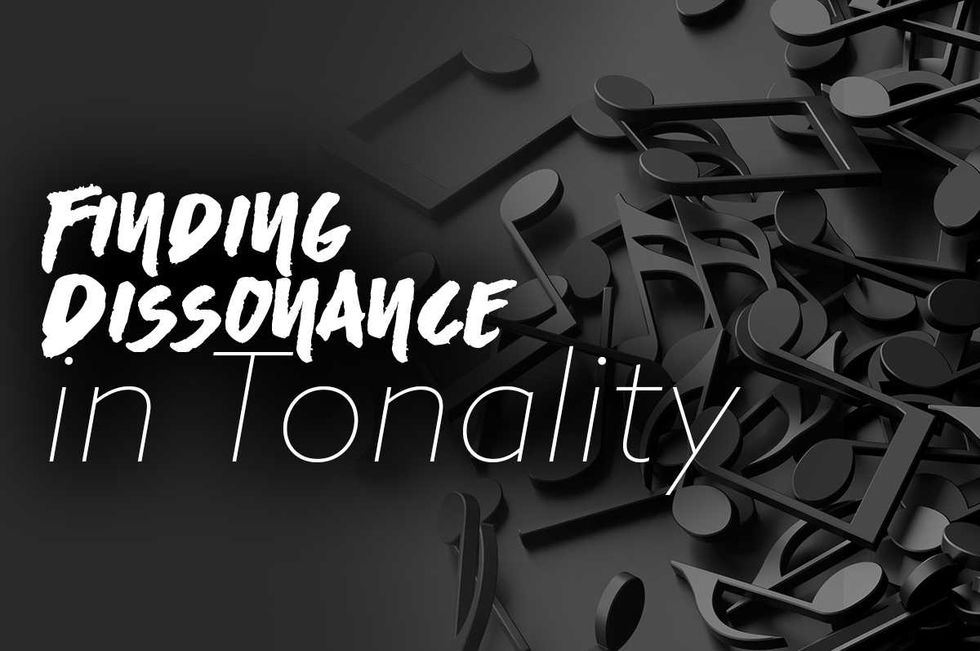
This is a lesson in what I call “finding dissonance in tonality.” The goal here is to focus on creating arpeggiated chord shapes and riffs that use tense intervals like 2nds, tritones, and 7ths, while still remaining in a particular key signature. This creates a haunting and moody sound that I often like to think of as “pretty dissonance.” In these examples we will find progressions that are dissonant yet still diatonic. It is a sound I use quite often in my own music and one that my ears are naturally drawn to.
Ex. 1
Ex. 1 demonstrates this concept by picking a key—in this case A minor. Then, I decide on a modal sound in that key (D Dorian). Next, we construct chord shapes in that key to include things like stacks of 2nds, or tritones mixed with 2nds. We have to look at our key signature and find which notes give us 2nds, tritones and 7ths. In this case, the notes we want to utilize are B and C, and E and F for our minor 2nds (or major 7ths depending on which note is in the bass). We’ll use A and B, D and E, and G and A for our major 2nds, and F and B for our tritones.
You might find that this example has a pleasing sound, despite the dissonance, since Dorian has a dreamy and nostalgic feeling to it. Yet the particular mix of intervals gives it a certain tension. The stretches here can be challenging, and there is a bit of movement around the neck. This example sounds best when played with a clean sound with all the notes ringing out together. We also have some time signature changes to keep us paying attention as well.
Ex. 2
For Ex. 2, we’re in the key of G major and are focusing on using a combination of 2nds, tritones, and 7ths to create some lush modal chords. The tension in these chords in particular is created by the G root note of chord one ringing against the F# on the D string, creating a major 7th. Then, we have that same F# hitting a C to create a tritone. Finally, the C to open B string at the top is creating a minor 2nd. Chord two has the major 7th again with the low C to B, then we have a major 2nd with the E to F#, and at the top of the chord, that same F# against the open E, creating another major 2nd. The final chord uses tritones again with the F# to C and then up to F# again. The top of the chord has an A to open B creating a major 2nd. This is a good example of how to create uplifting, major-key progressions that have a little spice to them.
Ex. 3
Ex. 3 takes the same chords of Ex. 2 but “octave displaces” certain notes to create wider spread voicings. The note relationships are still the same, it’s just that some notes have now been placed an octave higher throughout the progression. This makes it a bit more challenging to play, so I’ve taken the bpm down a bit. In general, I recommend practicing these very slowly at first and aiming for clarity and articulation. Utilizing the approach of octave displacing can create some very interesting melodic sequences. It is a fantastic way of creating a variation out of something you’ve already written.
So far these examples have been fairly light and bright sounding despite the dissonance in the chords. Ex. 4 gets a little darker and more tense. It’s also in 5/4 time. Based in the key of D minor, this riff heavily focuses on using minor 2nds. First, I look at the key signature, which has one flat: Bb. Next, I find which notes in the D minor scale give me minor 2nds. These notes are A to Bb and E to F. Bb to E also gives me a tritone. Once again, there is a bit of movement all around the neck in a short amount of time.
Ex. 5
Ex. 5 is again in D minor but more of a lower-register riff. In this example, I also use a somewhat tense interval we haven’t talked about yet, the minor 6th. In the first three notes of the example, we have a D to an A. Nothing tense there, just a perfect 5th. Next, though, is an A to a Bb—a minor 2nd. In addition, the relationship between notes one and three is a minor 6th. This interval appears again as the last dyad in the first bar. Those first three notes (D, A, and Bb) give us a sus b6 chord shape. I first came across this chord in the song “Guardian” by Fates Warning. Their guitarist Jim Matheos uses a lot of these haunting interval combinations, which became an influence on me early on in my playing.
Ex. 6
I encourage you to find some chords and progressions of your own that take inspiration from this approach. I’ll leave you with Ex. 6, a simple way to start. Take some basic major and minor chord shapes and add extensions to them like 2nds, 4ths, 6ths, etc. Chord one is an Am(add9), which is the 2nd moved up an octave. Chord two is a Cmaj(add#4). Chord three is a Bm(add11/b9). Chord four can be thought of as an inversion of Cmaj(add#4). The E in the bass makes it sound very dark. Those new scale tones create extra tension and dissonance and automatically make what you’re playing sound more evocative. Try these ideas out and see what paths they take you down!
Totally Guitars Weekly Update October 10, 2025
October 10, 2025 This week I spent a bit of time revisiting my Jim Croce albums. He was a big influence on me and I spent countless hours figuring out all his songs as each album was released. I even found myself singing most of them, although certainly not with the great style and delivery […]
The post Totally Guitars Weekly Update October 10, 2025 appeared first on On The Beat with Totally Guitars.
Totally Guitars Weekly Update October 3, 2025
October 3, 2025 Somehow this has turned into a Beatles week for me. It may have started with campers at IGC playing Drive My Car late one evening. It made me wonder if I had a lesson on it, and was surprised to find we did not have one. Then I got a couple requests […]
The post Totally Guitars Weekly Update October 3, 2025 appeared first on On The Beat with Totally Guitars.
Podcast 520: Ben Garnett
Guitarist Ben Garnett joins us this week to talk about the making of his new acoustic album, Kite’s Keep.
Garnett’s journey as a musician is one-of-a-kind. This former tuba player became infatuated with the guitar thanks to his uncle, Andy Timmons. He then discovered the Punch Brothers, immersed himself in bluegrass, and now has actual Punch Brothers on his new album.
Give it a listen and then go check out Kite’s Keep on all the streaming platforms.
Our new, 57th issue of the Fretboard Journal is now mailing. Subscribe here to get it.
Our next Fretboard Summit takes place August 20-22, 2026, at the Old Town School of Folk Music in Chicago. https://fretboardsummit.org
Mike & Mike’s Guitar Bar: https://mmguitarbar.com
Peghead Nation: https://www.pegheadnation.com (Get your first month free or $20 off any annual subscription with the promo code FRETBOARD at checkout).
Photo: Natia Cinco
The post Podcast 520: Ben Garnett first appeared on Fretboard Journal.
Meet the Brands Powering the DIY Guitar Revolution
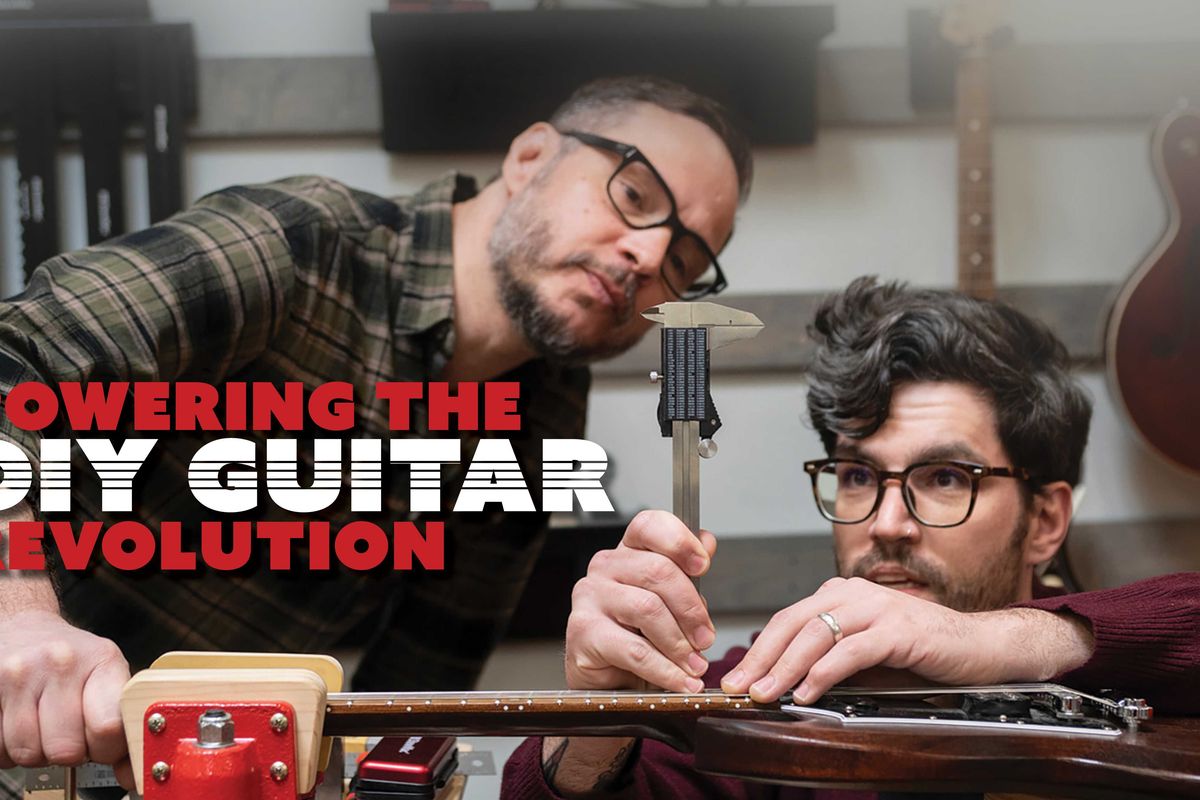
If you like to make, mod, or mess with your instrument, chances are you’re familiar with StewMac and Allparts. Here, their people tell us how they became the go-to suppliers for DIYers around the world.
It’s easy to forget, but it takes all manner of materials, tools, and know-how to make and maintain a well-loved guitar that’s built to last and plays exactly the way you like it. Pickups, tone knobs, toggle switches, and input jacks. Neck plates, bridges, tailpieces, and saddles. Strap buttons, truss rods, pickguards, string retainers, tuning keys, fret wire, ferrules. Capacitors and circuitry, nuts, and washers, screws and springs. Not to mention the tonewoods and specialized luthier tools used to fashion the body, neck, headstock, and fretboard.
These days, it’s not hard to find the parts and tools that guitarists need to make, repair, or upgrade their instrument. But decades ago, it wasn’t so simple. Before the days of online forums and same-day shipping, guitarists, luthiers, repair techs, and shopkeepers often had to scour the earth for the specific part they were looking for, or make do with an imperfect replacement.
Into that flawed and frustrating market stepped a few enterprising enthusiasts determined to streamline that search for the perfect part. The idea was simple: What if we just sold all of it? Every knick-knack and doodad, all in one place?
In the process, StewMac and Allparts emerged as the leading suppliers of guitar parts and tools, making it possible for nearly anyone to pursue their own quest for the perfect tone.
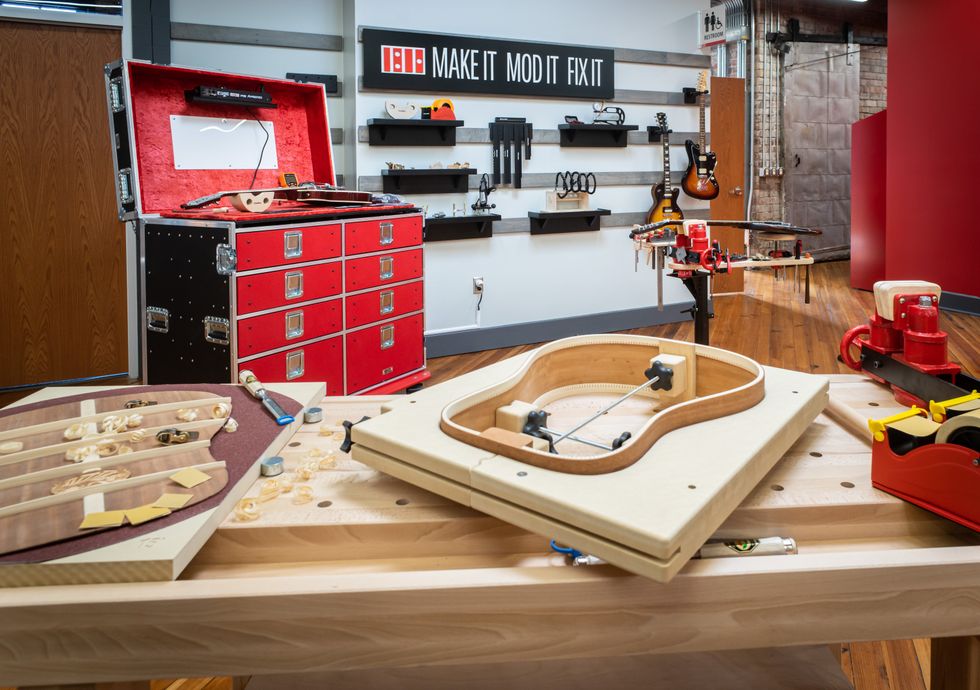
Leading a Community of Luthiers
StewMac’s motto is “making guitars better.” But in the beginning, the brand had almost nothing to do with guitars.
In 1968, Kix Stewart walked into a music store in Athens, Ohio, to repair his banjo. He became friends with the owner, Bill MacDonald, and the two started building their own banjos. Not satisfied with the banjo heads available on the market, they developed their own. Soon, they realized they were making more money selling the individual parts than they were from the banjos themselves. So, Stewart and MacDonald focused on the parts, expanding their business with banjo assembly kits and mandolin components.
The biggest evolution yet came in 1986 with the addition of Dan Erlewine, now one of the most well-known names in lutherie and guitar repair. The company began not only selling guitar parts, but also developing their own specialty tools. Today, the company now known as StewMac is one of the world’s foremost suppliers of tools, parts, and woods for stringed instruments.
Still headquartered in Athens, a small city about 75 miles southeast of Columbus, the company employs just over 100 people at its four-story, 60,000-square-foot warehouse, which houses an inventory of more than 7,000 different products. About 15 percent of that is made, assembled, or modified at StewMac’s facility, while the rest is sourced from third-party suppliers. Elsewhere, StewMac runs their European distribution through the Spanish luthier company Madiner, which carries StewMac products and sources many of the tonewoods they sell.
On the average day, StewMac will ship out at least 800 orders, and during especially busy times—the holiday season, for instance—they can see up to 2,000 orders each day. A team of two dozen pickers works on the warehouse floor, shipping out orders within hours of when they’re received.
“Everybody that works here plays guitar, repairs guitars, builds guitars. It’s not so much a job as it is a calling.”—Brock Poling
As Brock Poling, StewMac’s vice president of marketing, explains, the company has succeeded largely because of its passion for the craft. Poling is a luthier himself, and he was a StewMac customer before he joined the team in the early 2000s.
“We’re not just a company that’s selling you stuff,” says Poling. “Everybody that works here plays guitar, repairs guitars, builds guitars. It’s not so much a job as it is a calling.”
There are several reasons why StewMac has managed to grow from a two-man operation into an international enterprise that’s been in the business for 57 years.
One important factor is their focus on specialty tools. Some of the company’s bestselling products include fretting tools and bending machines that were developed in-house by expert luthiers. This year, two of the hottest products have been the J Edwards Fractal Fret Press, handcrafted by Texas-based luthier Jerame Edwards, and a new acoustic guitar side bending system, designed in-house with input from Charles Fox, the original inventor of the universal side bender.

Among StewMac’s other bestsellers are all-in-one kits that come with everything a beginner needs to complete their own project. The company introduced its acoustic and electric guitar kits in 2017, and a few years later expanded to offer a line of pedal kits, including the highly popular Ghost Drive, a do-it-yourself clone of the Klon Centaur.
“We’ll have people sending pictures of amp kits they’re working on, asking, ‘Where did I go wrong?’ And we’ll help troubleshoot.”—Ally Campbell
But what has really made the difference in the company’s business model, Poling says, is its strategic focus on how-to guides and video tutorials. StewMac has nearly half a million subscribers to its YouTube channel, which offers more than 500 videos about building, repairing, and maintaining guitars.
“This opens a new avenue to give someone a new idea, a new project, a new thing to pursue,” says Poling. “I’ve built our pedal kits. That is a new thing for me. I’ve never really built anything like that before. It’s fun, because not only is it a new project, it’s also a new set of skills.”
In essence, StewMac has fostered a community of users who are regularly looking for ideas for their next project—and conveniently, StewMac has all the parts and tools to bring those projects to life.
“We’ve really tried to look at this as if we are YouTubers first and a brand second,” says Poling. “We don’t sell, we don’t pitch. We want to provide value to the people that are watching these videos. The tools and materials that are in our videos are just cast members in the story.”
Poling says that while a small percentage of the company’s customers are professional builders, the majority are hobbyists. In 2020, when Covid pandemic forced most people to stay at home, StewMac saw an “enormous lift” in sales, Poling says.
There are about 30,000 subscribers to the StewMAX membership, which offers free shipping and returns, discounts, and monthly offers. And if anyone runs into problems, StewMac has plenty of people around to help.
“We don’t just have customer support reps to help with orders—we also have a team of guitar techs who can walk you through projects,” says Ally Campbell, StewMac’s social media manager. “We’ll have people sending pictures of amp kits they’re working on, asking, ‘Where did I go wrong?’ And we’ll help troubleshoot.”
StewMac has tapped into a community constantly on the lookout for the next invention to make guitar work faster, easier, better—or all of the above. That’s also where Allparts shines.
“Recession-Proof”: The Timeless Appeal of DIY
While StewMac was still in its early years peddling banjos, the manager of a music store in Houston had his own idea for a company that would sell the guitar parts he had always had such a hard time finding.
In 1982, Steve Wark started Allparts in his garage, working several part-time jobs to take care of his new family while he cold-called music stores across the country to sell his catalog of 115 hard-to-find products he had sourced from a single Japanese supplier.
“You can’t necessarily count on another Eddie Van Halen and Floyd Rose combination coming along. So, we have to think as players: What would be interesting?”—Dean Herman
Throughout the ’80s, Allparts benefitted from strong sales of metal parts, particularly a bestselling tremolo that was marketed as an alternative to the Floyd Rose, just as that product exploded in popularity thanks to shredders like Eddie Van Halen, Joe Satriani, and Steve Vai.
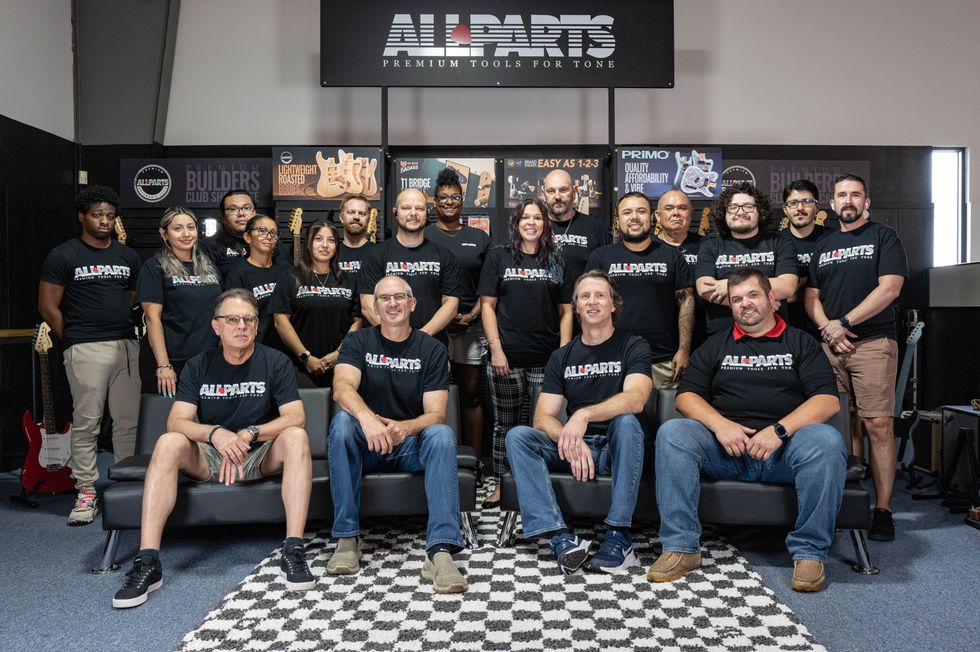
Nowadays, Allparts sells more than 3,500 items from suppliers in 18 countries, and it fulfills thousands of orders per month. Far removed from Wark’s garage operation, Allparts employs roughly two dozen people at its 13,000-square-foot facility in Houston.
“The company has always been fairly lean. “Everybody here wears a couple of hats,” says Allparts president Dean Herman. “We’re very capable of being able to adapt to whatever the business calls for.”
By 2020, Wark had sold Allparts to the private equity firm Ambina Partners and was planning his retirement. Herman joined the company after 25 years at Fender, where he had worked his way up from junior rep to sales director. First hired as Allparts’ vice president of sales and marketing before being promoted to president a few years later, he was tasked right away with modernizing the company’s e-commerce site, sales and inventory system, and order fulfillment.
Five years later, he reports that results have been positive across the board: a boost in sales, improved logistical efficiency, and a superior customer experience. The company now keeps pricing and inventory more accurate, ships most web orders the same day, and has strengthened its product descriptions to help customers understand each piece of gear and why it could be the right fit for their rig.
Allparts receives a lot of high-volume, lower-priced orders for small, highly specific parts with “evergreen demand,” like jacks, switches, pots, and knobs. But their real bestsellers are the premium, player-oriented aftermarket upgrades, like Leo Quan’s Badass bridges and tuning keys, and the relatively new Certano T-Bender bridge for Telecasters.
Herman is particularly proud of the T-Bender, which was designed by the French craftsman David Certano and further developed in partnership with Allparts. The bridge serves as a simplified alternative to B-Bender and G-Bender bridges, offering players the ability to bend their B or G string up to a full step to get those classic pedal steel sounds. But unlike its predecessors, it doesn’t require any extra drilling or routing to install, and is fully reversible. That makes it way more accessible to players curious to try it out, but who don’t necessarily want to spend hundreds of dollars and permanently retrofit their guitars in the process, Herman says.
“I don't have illusions that [the Certano T-Bender is] ever going to take the place of a Glaser Bender or anything,” he says. “But we just thought an elegant, more-DIY friendly solution would offer players a fun way to dip their toes into that arena, and to take their playing in a different direction without having to modify their instruments.”
That’s exactly the type of new product that Allparts is training its sights on. Herman says he’s excited about the prospect of working with new collaborators who have great ideas that satisfy a niche market—something that’s more challenging today than in previous decades.
“It’s always a good time to be in the parts business.”—Dean Herman
“In the past, it might have been a little easier,” he says. “There was a predominant style of music that you could attach yourself to, and you could come up with an item that catered to a specific crowd. Nowadays, there's a zillion different kinds of players listening to a zillion different kinds of music. So we’re looking for interesting little niches, and that next thing to get excited about. You can’t necessarily count on another Eddie Van Halen and Floyd Rose combination coming along. So, we have to think as players: What would be interesting? What would people find compelling?”
It’s that type of thinking that gave Allparts a leg up in the market when Wark was still getting the company off the ground in the ’80s, and it’s what continues to push the company forward more than 40 years later. To be sure, Herman says, “We have lots of other fun ideas in the works.”
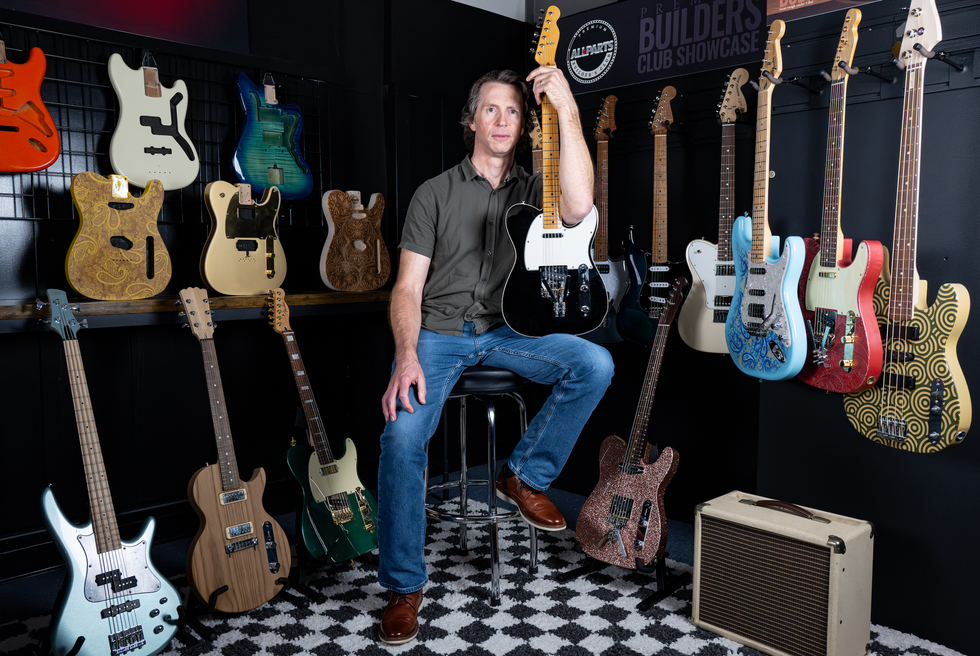
Throughout the years, Allparts—much like StewMac—has weathered economic shifts well, relatively speaking. While many American businesses have grappled with the effects of the Trump administration’s new tariffs, both Allparts and StewMac are navigating the situation carefully, and neither reports seeing much of an effect. Similarly to how Brock Poling of StewMac referred to a sizable share of the company’s product line as “recession-proof,” Herman sees opportunities for Allparts to thrive in virtually any economic situation.
“If the economy is great, people are buying guitars and basses, and builders need cool, differentiated parts that offer their customers something new they haven’t seen before,” he says. “But if the economy’s not great, the repair side of the business does better. So in our view, it’s always a good time to be in the parts business. It’s always a good time to be thinking about cool, innovative upgrades for musicians.”
Stompboxtober 2025: Lehle
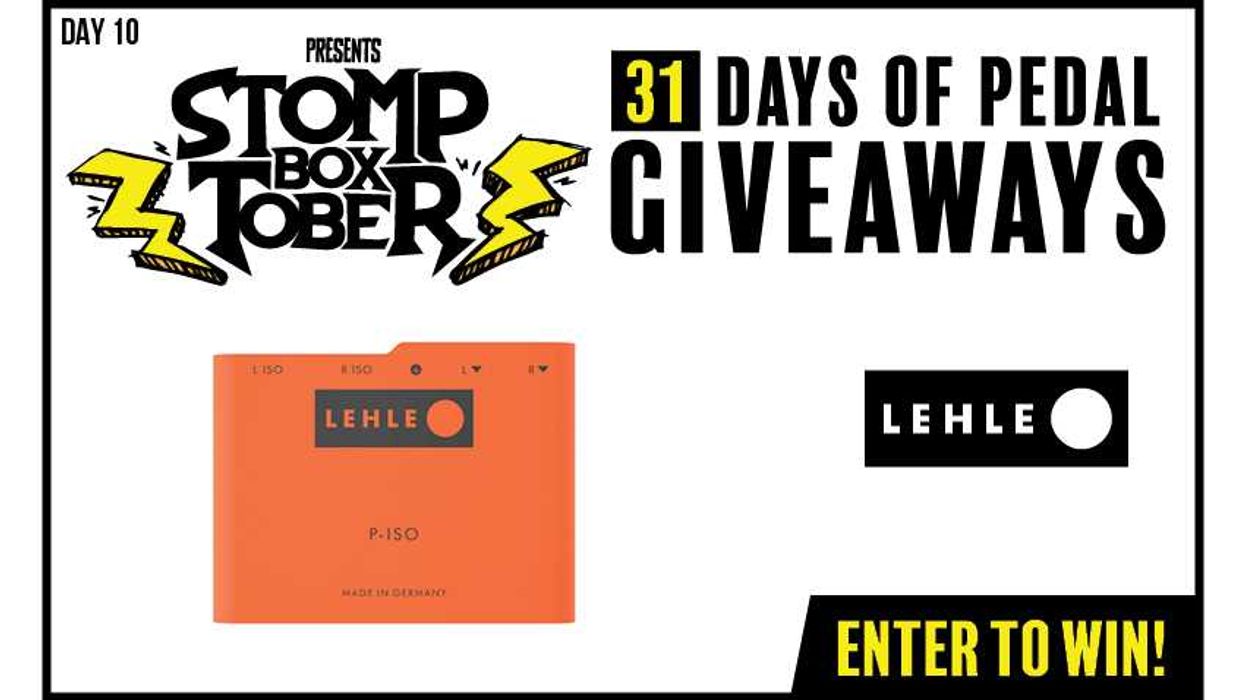
Today’s spotlight pedal (okay, box) is the LEHLE P‑ISO TRS XLR Stereo — your secret weapon against hum and noise. Enter now to WIN this passive isolator/DI box that converts stereo TRS to balanced XLR while lifting the ground to banish unwanted loops. Don’t forget — new giveaways drop every day this October!
Stompboxtober 2025 - Win Pedals All Month Long!
LEHLE P-ISO TRS XLR STEREO

he LEHLE P-ISO TRS XLR STEREO brings you closer to the main mixing system. It converts your stereo audio signal not only to balanced XLR but lifts the ground so there’s no chance of unwanted noise or humming loops. Perfect for your pedal board, modeler and amp simulation in studios, clubs, bars or stadiums – all fitted into a handy size.
The combination of passive isolation with highest possible signal fidelity is only realisable thanks to its core, existing of two LEHLE TRANSFORMER HZ, which galvanically isolate the signals.
While being designed especially for high impedance signals, they process low impedance signals with the same uncompromising sound quality as well. The high coupling and flat frequency response won’t let you miss any detail in the signal.
The classic application for the LEHLE P-ISO TRS XLR STEREO is the connecting link in between your stereo device and the professional world of mixers, FOH and DAW recording systems.
It lifts the ground in between those worlds, so the devices are galvanically isolated - any hum or noise caused by a ground loop becomes a thing of the past. Offering balanced audio signals at the two male XLR sockets by Neutrik gets you protected even closer to the mixer while using simple standard XLR cables.
Not only for stereo effects, digital modeler and amp simulation devices - even keyboards, synths, playback systems or audio interfaces are in safe hands of the LEHLE P-ISO TRS XLR STEREO.
You won’t find a power connection as you get all the performance of that compact box passively, without the need for a power supply.
And due to its optimised size and low weight, it fits easily below your pedalboard or in any pocket - always installed or as flexible tool to share.
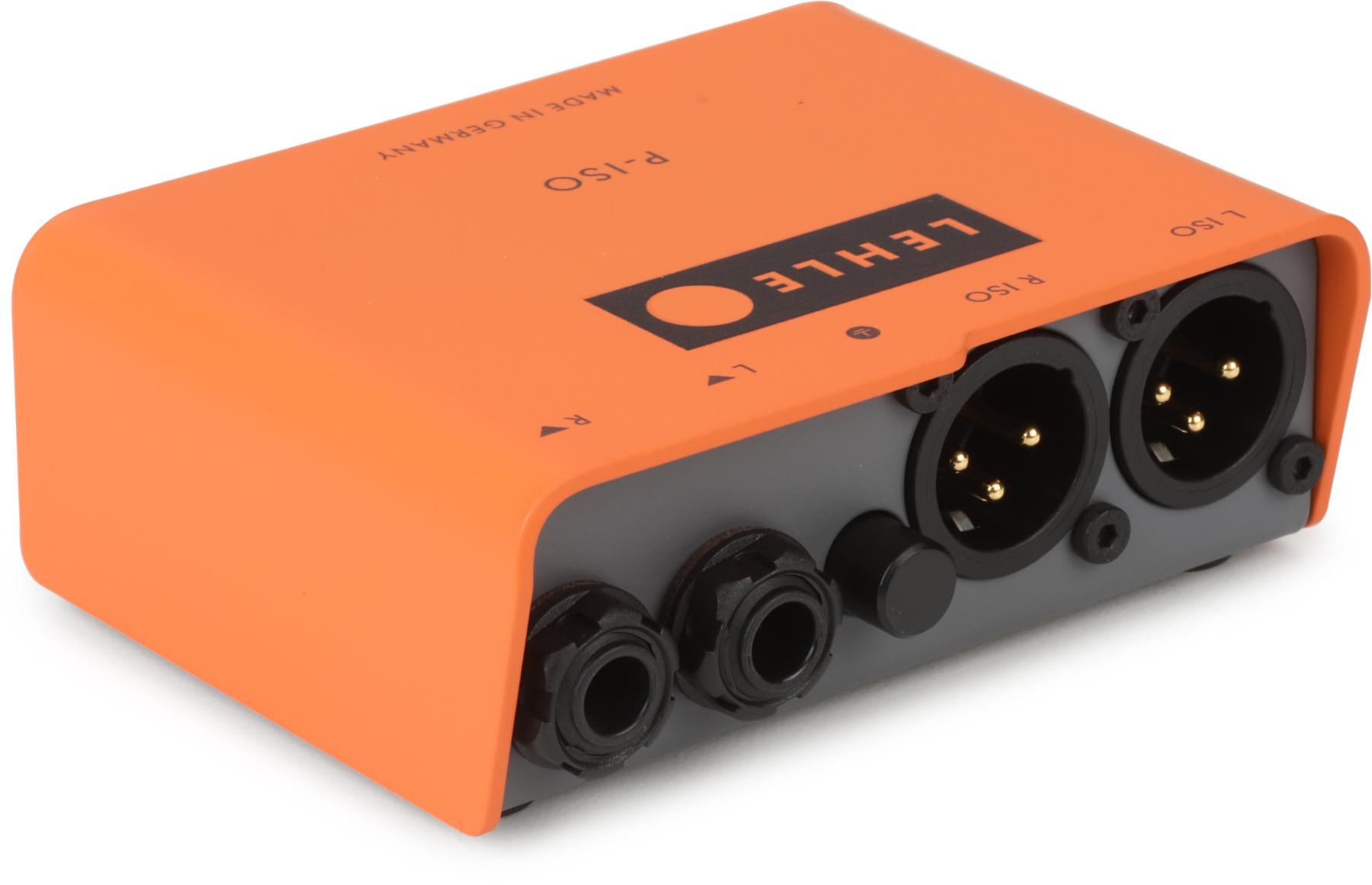
Lehle P-ISO TRS XLR Stereo Isolator and DI Box
Question of the Month: To DIY or Not to DIY

Question: What have you DIYed in your rig?
Karla Chubb (SPRINTS) - Guest Picker
A: Besides my entire playing style and mess of a pedalboard? I’d say my Jagstang, which is my main touring guitar. It’s starting to become a bit of a Frankenstein's monster purely due to use (and destruction) on the road. Originally I just modified the bridge, replacing the standard one with a Fender American Pro Mustang bridge. This was supposed to help the strings stop slipping out of tune when I struck them too hard playing live. I have since lost the original tremolo bar (and the screws) so I can’t attach a new one. Instead, I duct-tape whatever Jazzmaster/Jaguar/Mustang one we have lying around on at every show because I’m too lazy to get it fixed. I should really get around to that…
Obsession: My current obsession at the moment is terrible (and rarely not-so-terrible) true-crime documentaries on Disney+/Starz. If what they say about smart people loving reality TV is true, then I must be a genius. From The Secrets of Hillsong to Mr. & Mrs. Murder, there is nothing that helps calm my brain or shut it down more than a terrible whodunnit. I love you, true crime. Never change.
Randall Brown - Reader of the Month
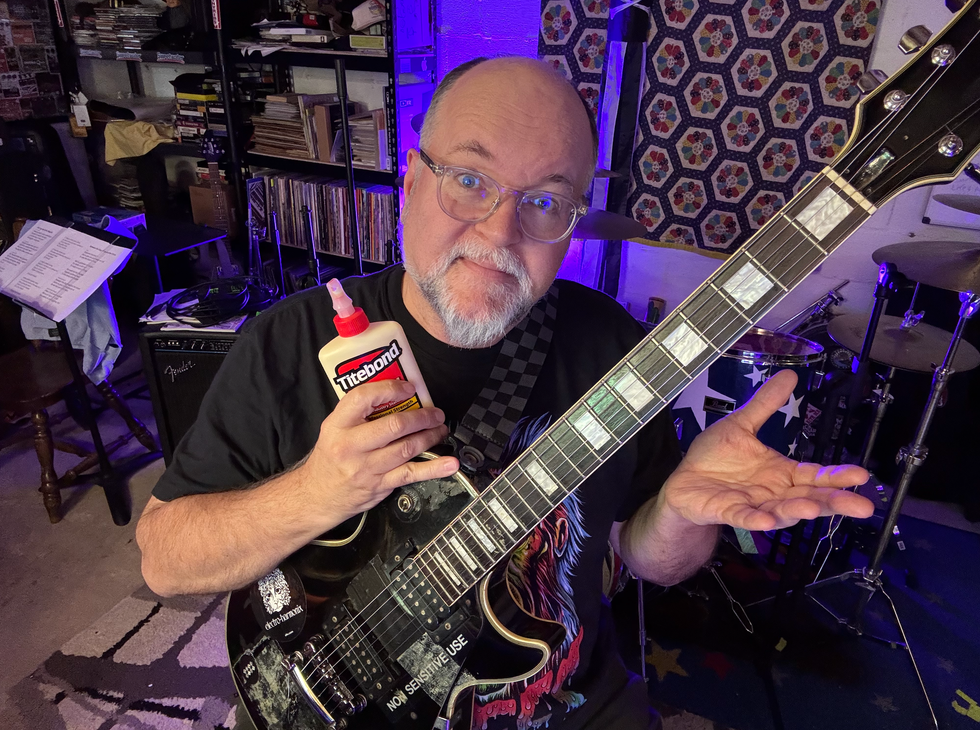
A: My most in-depth DIY so far is a sad tale! I tried to upgrade my very old and beaten-up—but still very playable—Memphis Les Paul copy with new tuners, bridge, and tailpiece. While working the posts in for the new tailpiece, I heard a wooden creak and a snap. My attempt to firmly plant the poles had caused the laminate top to politely separate halfway off the body. I bought wood glue and clamps to do more serious repairs, but I haven’t trusted my (lack of) skills to actually start. If I can’t find just the right YouTube tutorial, I might have to seek professional help.
Obsession: P-90 pickups and the music of Osees. I bought a Rivolta Zenyata earlier this year, and its neck-position P-90 has won my tone-heart. I love full-on humbuckers, but when I commence repairs on the old Memphis again, I want to replace its ancient no-name HBs with P-90s. Coincidentally, I’ve been obsessing over John Dwyer’s guitar wildness with Osees, and he gets amazing sounds out of his P-90-packed Les Paul Junior.
John Bohlinger - Nashville Correspondent

A: DIY is part of the guitar’s DNA. From its humble lute origin over 1,000 years ago, players have been altering the instrument ever since to create the sounds in our heads. Les Paul and Van Halen are prime examples of players who reshaped the instrument, and in doing so, reshaped music. I’ve tweaked every instrument I’ve owned, swapping pickups, sanding bodies, adding Bigsbys, adjusting setups, or hiring luthiers to add B-benders. Honestly, many of these DIY tangents have ended in expensive, frustrating, lateral trades. That’s the thing about obsessions: They do not call reason into question.
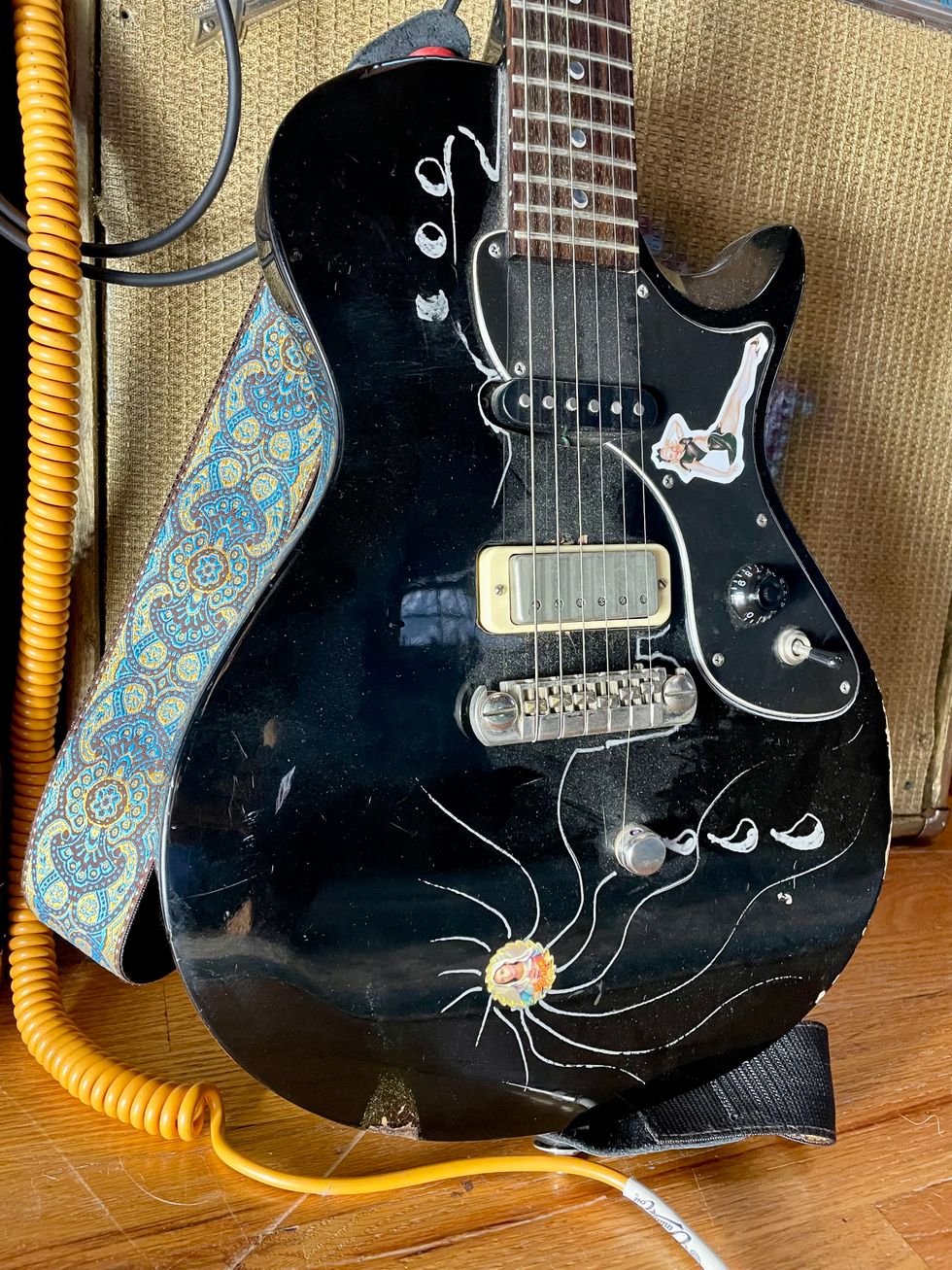
Obsession: Of late, it’s working flatted or raised 5ths into solos. It’s fun to shoehorn in the devil’s interval, with its foreboding dissonance, and try to resolve into something sweet.
Luke Ottenhof - Associate Editor
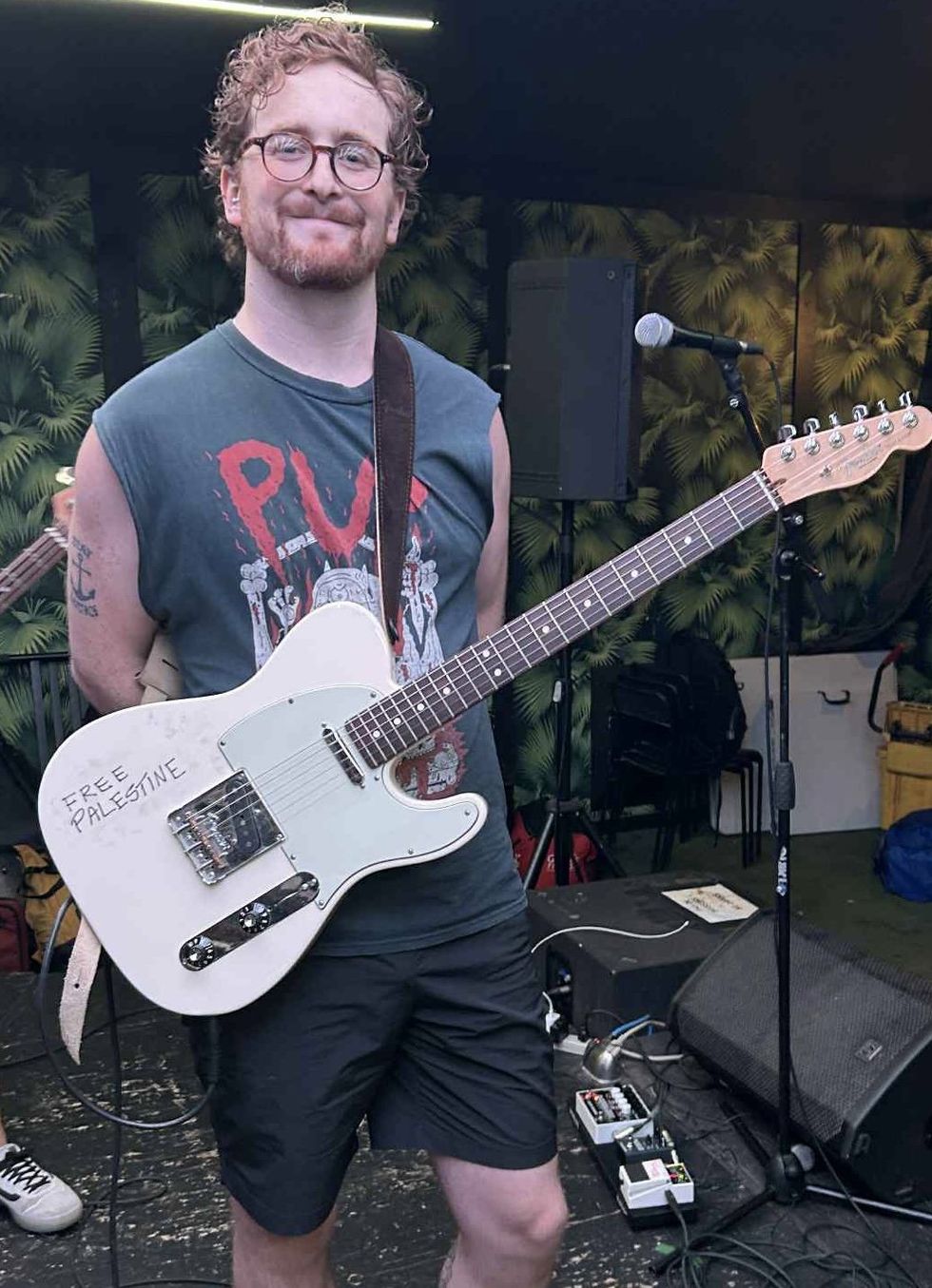
A: I love DIYing stuff in my rig, even though I have little to no idea what I’m doing a lot of the time. Last year, I used an ill-equipped dremel to clumsily carve out space under a small aluminum pedalboard for my power supply, then superglued some rubber feet onto the board for more clearance underneath. A smarter person might have simply bought a board that could accommodate the power unit without mods, but where’s the fun in that?
Obsession: The new Alien: Earth series on FX. The major plot device is so original but totally believable, and the atmosphere is delightful: ’80s sci-fi aesthetics mixed with contemporary special effects and some bizarre, unsettling new creatures. Plus, the awesome needle drops at the end of each episode, featuring classic metal songs. TV can and should be this fun—while also still being very good.

Samantha Fish on the top blues players right now, and why one of them is “an alien”

She might regularly appear in ‘best blues guitarist’ polls, but Samantha Fish doesn’t believe you can really rank musicians. “I feel like being a guitar player is all about self-expression,” she says in conversation with Guitar World. “So when you’re ranking guitar players, it’s tough for me, because I don’t think there’s one better way to do it.”
- READ MORE: Christone “Kingfish” Ingram picks his six most influential blues guitar albums of all time
But everyone has their own personal favourites, and during the interview the Kansas City guitarist name-drops a few. “I just got off the road with [Christone] Kingfish [Ingram], and he’s pretty amazing” she exclaims, before going on to list the other greats in her mind.
“I think Derek Trucks is one of the greatest there is, not just in blues playing but any playing. He’s an alien. I like Gary Clark Jr. – he’s very tasteful, and he’s got a great tone. Eric Gales is incredible. He just blows everybody away. Luther Dickinson is one of my favourite contemporaries, too. He’s awesome.”
UItimately, what matters to Samantha is having a distinctive sound, which she describes to Blues Blast back in October 2024, “I love anybody with a personality…so you can just turn (a song) on and you know exactly who is holding that guitar because they have that personality. I think Keith Richards has that personality. I think (of), obviously, B.B. King. I think Derek Trucks has that personality. Freddie King has that personality. I think Angus Young (of AC/DC), and I think of Jimmy Page.”
Samantha was lucky enough to play with her hero Keith Richards as opener for The Rolling Stones’ on their Hackney Diamonds US tour, which she found “humbling and mind-boggling”.
Slash also asked her to play at his own blues festival, the charity fundraiser S.E.R.P.E.N.T., alongside other giants like Warren Haynes, Keb’ Mo’ and Larkin Poe. She told Louder Sound that she was initially sceptical about the invite, “But then it actually came through and I thought, it’s a cool concept and such a cool lineup. All the acts are really incredible performers and it’s a really great thing to get to be a part of. I was stoked.”
The post Samantha Fish on the top blues players right now, and why one of them is “an alien” appeared first on Guitar.com | All Things Guitar.
Steel: Travis Toy
On Episode 14 of Steel, we meet Travis Toy, one of Nashville’s deepest pedal steel players. Travis has shared the stage and studio with some of modern country’s biggest acts, including Luke Bryan, Rascal Flatts, Luke Combs, Steve Wariner and Patty Loveless.
Travis is one of the deepest technical practitioners of pedal steel. He’s just as comfortable playing a honky tonk gig as he is shredding jazz funk fusion on E9. We discuss his fascinating musical upbringing in Kentucky, his obsession with ’90s country and GRP records, how he tries to play things that matter in the studio, and lots more.
Read more about Travis here:
http://www.travistoytutorials.com/
https://open.spotify.com/playlist/3WdOaE9fKZThXhFWU9dsfe?si=78e43673760841d4
Steel is brought to you by the Fretboard Journal magazine and is mixed by Armen Bazarian.

The post Steel: Travis Toy first appeared on Fretboard Journal.
Alex Lifeson reveals the challenges of bringing Rush back for their reunion tour

Following Neil Peart’s retirement in 2015 and sad passing in 2020, it looked like Rush would never play again. But in recent months, Alex Lifeson has given plenty of hints that things might not be over for him and bassist Geddy Lee.
That said, few anticipated the shock news this week that Lifeson and Lee would be reuniting for a seven-city tour in 2026 including US, Canada and Mexico dates.
While playing without Peart might be tricky to navigate, what Alex Lifeson is really concerned with is relearning Rush’s old material. “50-something years” into his service as guitarist, Lifeson admits in a Rock and Roll Hall of Fame interview that their songs are still difficult to play: “When you do it every day, it’s not a big deal, really.”
“You’re used to it. But when you’re away from it, and you are a little more objective about the intense complexity of the music and the feel and the new nuances and all the things that go into making a Rush song and performance”.
Despite this, Lifeson enthuses that: “to be challenged with that again was really, really exciting. And the more we started rehearsing and playing, the more I just fell in love with the idea of playing again.”
A Rush reunion wasn’t always so clearly on the cards, as losing Peart initially made the idea of reuniting difficult. As Geddy Lee admits in the same interview: “First of all, because [of] what it entails in terms of work, but also what had transpired, you know, losing a member like Neil is devastating.”
“It was a very sad time, and it took time for us to even contemplate. This is a relatively recent decision, and I would say it was kind of out of the question for the longest time because of those circumstances – and how do you replace someone who’s irreplaceable?”
Their final decision was endorsed by both Peart’s daughter Olivia Peart and his wife Carrie Nuttall, who shared in a press statement: “We are thrilled to support the Fifty Something tour, celebrating a band whose music has resonated and inspired fans for generations, and to honor Neil’s extraordinary legacy as both a drummer and lyricist.”
“As the band enters this new chapter, it promises to be truly unforgettable. We are excited to see how their new vision unfolds, and to hear this legendary music played live once again.”
German drummer and composer Anika Nilles is now taking over from Peart’s duties, expressing in an Instagram post how “overwhelmed” she is after being thrust into the spotlight by fans of the band.
The post Alex Lifeson reveals the challenges of bringing Rush back for their reunion tour appeared first on Guitar.com | All Things Guitar.
Slash confirms that he didn’t like this iconic Guns N’ Roses song: “I have to admit I did have a thing with it”

Musicians often become sick of their own hits – Robert Plant even claimed he’d “break out in hives” if he’d have to sing Stairway To Heaven at every show.
Guns N’ Roses’ Slash is a little different however, admitting to Guitar World interview that he didn’t like Sweet Child O’ Mine even before it was a hit. Before its writing, Slash considered Guns N’ Roses a “Motörhead-type hard rock band”. But in hindsight, he thinks this ballad helped them to reach fame, being their only US number one single in 1988.
Some of Slash’s distaste for the track might boil down to how challenging the song’s solo is to play. Particularly live – and drunk – as he reminisces: “We played it one time opening for Ted Nugent, and when it was time to play the song, I was like ‘Oh fuck’. And of course, I had to remember how to play the riff accurately by myself in front of everybody every time.”
These days, Slash feels more neutral about its inclusion, saying “it’s become one of the big tentpole songs in the set. So it is what it is.”
When it comes to writing solos, Slash finds this more of a stream of consciousness flow rather than something he sets out to do. “All the solos were very spontaneous and at-the-moment the song was written. You figure out what the chord changes are going to be and then just do what you feel.”
Sweet Child O’ Mine was written in this exact way: “it was just a riff I came up with, and I didn’t know what I was going to do with it. I wasn’t really thinking about it at the time, but it inspired the whole song.” Their 1991 release November Rain’s solo also came about the same way: “It sounds so structured to me now, [but it] was just what happened in the moment.”
This isn’t the first time that Slash has felt at odds with the band’s creative output. He told Yahoo in 2022 that November Rain’s wedding concept music video went against his values as a “stripped down rock guy”, but being his diplomatic self does think “it came out pretty awesome”. At the end of the day, he “always knew it was a really great song”.
The post Slash confirms that he didn’t like this iconic Guns N’ Roses song: “I have to admit I did have a thing with it” appeared first on Guitar.com | All Things Guitar.
Lemonheads guitarist claims he doesn’t regret decades of hard drug use: “I think some people were supposed to take drugs”

Lemonheads guitarist Evan Dando is no stranger to rock star excess. From the alt-rock heyday of the early 90s to periods of public absence (and misadventures), the Boston band’s frontman has long earned a reputation for living life on the edge.
In a new interview with The Guardian, the 58-year-old opens up about his past substance use, his current approach to sobriety, and the creative process behind Love Chant, the band’s first album of original material in nearly twenty years.
These days, Dando considers himself “clean”, though his version of the word might surprise some: “I’ll take acid occasionally, maybe mushrooms and I’ll smoke pot.”
For the musician, being clean is about leaving heroin behind, which he claims he hasn’t used in nearly three years. The decision followed a disastrous gig at Hollywood Forever Cemetery in 2021, where he struggled to play through the set.
“I thought: ‘This is not good. The legacy will not bear this type of behaviour,’” says Dando.
He credits Laura Teixeira for helping him quit but stresses he has no regrets about his past: “I think some people were supposed to take drugs and one of them was me.”
Stepping back from substances (mostly) has also brought a new focus to his music.
“When you’re on smack, you’re all: ‘Oh fuck that, and that, and that,” he says. Now, Dando is finally releasing Love Chant, an album that revisits the lyrical and melodic strengths that propelled Lemonheads to indie stardom.
Formed in 1986, Lemonheads earned acclaim for their blend of punk energy and folk-pop melodies, scoring mainstream hits with songs like Into Your Arms and It’s a Shame About Ray. Despite lineup changes and long periods of inactivity, Dando has remained the band’s creative core, carrying its signature songwriting voice through the years.
“I’ve never really heard of this sort of dormancy period [between albums],” he admits. “This is some Rip Van Winkle shit. I do have integrity about what I put out. I wasn’t ready to do anything new until I was ready, and [now] I am.”
Love Chant will arrive on 24 October via Fire Records. Check out the latest single In The Margin below.
The post Lemonheads guitarist claims he doesn’t regret decades of hard drug use: “I think some people were supposed to take drugs” appeared first on Guitar.com | All Things Guitar.


